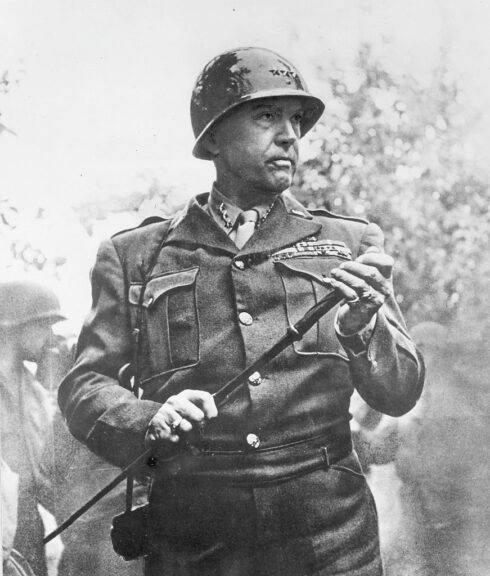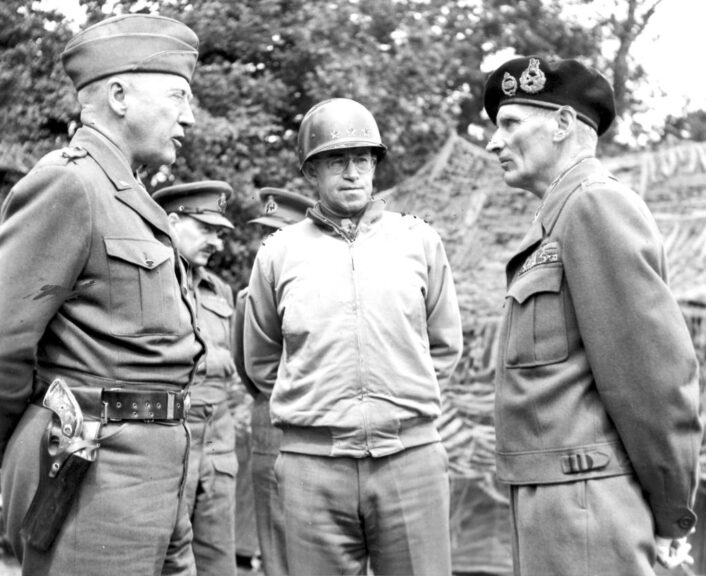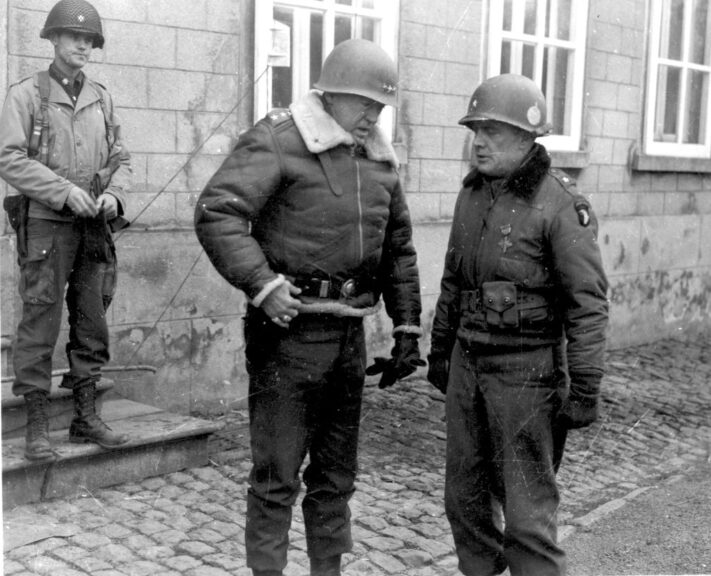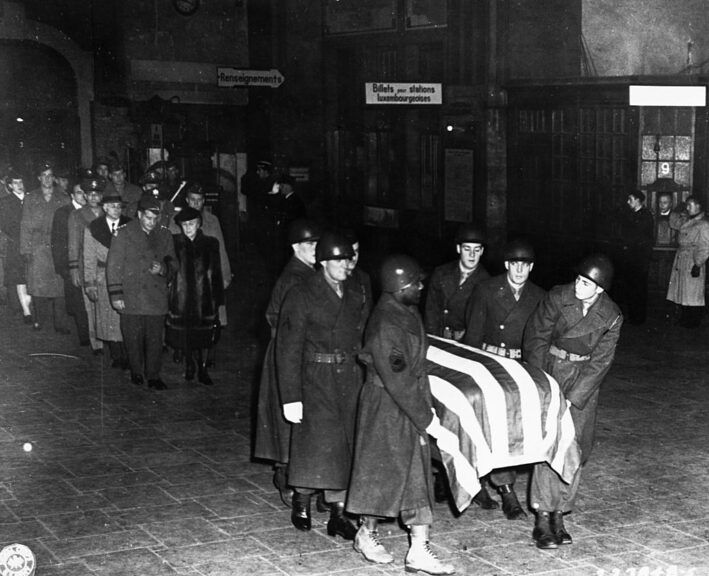Over the years, the United States has produced many remarkable generals and admirals, but only a few have stood out as world-class strategists and leaders of troops. As Veterans Day approaches on November 11, let’s remember and celebrate them. Here is my list of America’s finest 11 commanders.
George S. Patton Jr., 1885 – 1945 (World War II)
Much has been said and written about this American icon, and some of it is exaggeration to be sure. The Germans, for example, though they believed Patton the best Allied commander in the West, were not obsessing over his every move as depicted in the eponymous 1970 film. They did, however, expect him to lead the cross-channel invasion of Europe. Nevertheless, one of his most effective roles in the war was as a decoy to divert the German High Command’s attention away from the actual event in Normandy to prepare for Patton’s (fictional) First Army Group to land at Calais, which never happened.
But it was Patton’s exceptional skill, unrelenting drive to attack on the battlefield, and his unmatched understanding of highly mobile tank warfare that set him apart from the other ETO commanders.

GEORGE SMITH PATTON (1885-1945). American army officer. Photograph, 1944 (Photo by ullstein bild/via Getty Images)
His first success was to breathe life back into the demoralized U.S. II Corps in North Africa after its severe mauling at the hands of Rommel’s Afrika Korps at the Battle of the Kasserine Pass (February 1943). After taking over command from the incompetent Gen. Lloyd Fredendall, Patton quickly initiated a regimen of strict discipline and training. By the next encounter with the Wehrmacht at El Guettar (March 1943), it was the Germans who ceded the field.

American military commander Lieutenant General George S. Patton (1885 – 1945) sits on the sand and watches a tank battle in Tunisia, 1943. (Photo by PhotoQuest/Getty Images)
Next, Gen. Patton landed in Gela in Sicily. To his chagrin, his troops were positioned to merely act as a covering force for his rival British Field Marshal Bernard Montgomery’s drive north along the east coast to Messina. Montgomery’s forces were to cut off the retreating Axis from their only escape across the water to the Italian peninsula. The brash Patton, impatient with Montgomery’s plodding advance, effectively defied orders by detaching flying columns farther west through the Sicilian hills to fall upon the northern port city of Palermo. Showing grim determination to beat the British to Messina before the Germans could escape the island, the general even shot a farmer’s two mules when the stubborn animals held up a column under air attack, adding to the Patton legend.

American Generals George S. Patton (1885 – 1945) (left) and Omar Bradley (1893 – 1981) (center) speak with British General Bernard Law Montgomery (1887 – 1976), July 7, 1944. (Photo by PhotoQuest/Getty Images)
Once having taken Palermo, Patton whipped and drove his men as a jockey would a thoroughbred on the homestretch to Messina. His men arrived in the port city hours before Montgomery, satisfied that he’d proven to, what he believed to be, a condescending ally what properly led Americans could do. But by then the Germans had already made their escape across the Strait of Messina, promising years of bitter fighting on the rugged Italian mainland ahead.
It was during the Sicily campaign that Patton infamously slapped two soldiers: One was suffering from “combat fatigue,” what we now would call PTSD, which Patton saw as cowardice, but the other most likely had malaria and was combat ineffective. These actions earned him public ridicule, a rebuke from General Eisenhower, and almost got him sent home. For a baffled Patton, who knew the Germans routinely executed their own men for showing cowardice in the field, this was a bewildering response.

Dwight D. Eisenhower with General George S. Patton. Other military men are in the background. Getty Images.
By the summer of 1944, with his decoy work done, and having paid enough for the slapping incidents, Patton was back where he was most effective — in command of an army in the field. Placed at the head of the Third Army, he was the right man to lead the Allied breakout from the Bocage and into the heart of France, inflicting heavy casualties on the Wehrmacht along the way.
By December 1944, with France liberated and the Allies at the German border, the Allied high command was waiting out the winter while basking in the fruits of victory. They’d confidently deemed Germany incapable of offensive operations. But Patton was not so sanguine. Believing his own intelligence, which offered the Germans may try something desperate, he was already preparing his Third Army to pivot north to face just such an attack when Hitler launched his Ardennes offensive on 16 December 1944. Patton’s sudden and unexpected lurch ninety degrees to drive his entire army like a knife into the southern underbelly of the German salient was beyond the capacity of all but a few great commanders. The Third Army’s drive towards besieged Bastogne disrupted the German attack and liberated the town and its dogged paratrooper defenders on 26 December.

American military commander Lieutenant General George S. Patton (1885 – 1945) (center left) talks with Brigadier General Anthony McAuliffe (1898 – 1975), Bastogne, France, December 28, 1944. McAuliffe commanded the 101st Airborne Division, which was beseiged in Bastogne during the Battle of the Bulge, until the seige was broken by troops under Patton shortly before this picture was taken. (Photo by PhotoQuest/Getty Images)
However, Patton disagreed with his superiors Eisenhower and Gen. Omar Bradley on what to do next. The high command opted to gradually push the salient back with assaults along the entire front, rather than, as Patton recommended, cutting it off at its exposed base and killing or capturing those Germans trapped within. Patton fumed: “The Kraut’s stuck his head in a meat grinder and I’ve got hold of the handle!” In retrospect, given the heavy losses after Bastogne, Patton was probably right.
Famously nicknamed “Old Blood And Guts” for his relentless determination to close with the enemy and destroy him, one can only speculate how the war in Europe might have played out if Patton, rather than the timid John Lucas, had been in command at Anzio, Italy.
Lucas allowed Allied landing forces to sit idle for five days allowing the initially surprised Germans to surround and besiege the exposed beachhead for months. Later on in Italy, rather than the self-promoting Mark Clark, Patton surely would have pursued and attempted to destroy the retreating Germans rather than allow them to escape just to take the symbolic but strategically irrelevant Rome.
![American military commander Lieutenant General George S. Patton (1885 - 1945) (center, in helmet with three stars), Commander of the 3rd Army, visits men of 1303rd Engineers, whose completed bridge across the Sauer River linked Luxembourg and Germany, February 20, 1945. The sign reads 'Gen. Patton Bridge; Built by the MIghty Midgets [obscured] 1303 Engr.' (Photo by PhotoQuest/Getty Images)](https://dw-wp-production.imgix.net/2023/11/GettyImages-119460600-685x576.jpg)
American military commander Lieutenant General George S. Patton (1885 – 1945) (center, in helmet with three stars), Commander of the 3rd Army, visits men of 1303rd Engineers, whose completed bridge across the Sauer River linked Luxembourg and Germany, February 20, 1945. The sign reads ‘Gen. Patton Bridge; Built by the MIghty Midgets [obscured] 1303 Engr.’ (Photo by PhotoQuest/Getty Images)
As it turned out, Patton’s fears were correct. The end of Nazi Germany meant a new menace would take its place: Stalinist Russia. And so he protested that as little of Europe should be ceded to the Russians as possible, even if it meant military conflict. Interestingly, just seven months after V-E Day, while serving as military governor of Bavaria, the general was killed in a freak Jeep accident; speculation remains to this day whether it was a genuine mishap or a Russian hit. We may never know.

Pall bearers carry the casket of General George Patton through a Luxemburg train station. Patton was killed in a post-war traffic accident. (Photo by © CORBIS/Corbis via Getty Images)
Although Patton lacked the tact necessary to be a modern general/bureaucrat (a skill at which Eisenhower excelled) he was a consummate military man who knew how to win battles and inspire men to do the same.
Patton was one of the war’s most fascinating characters and a study in contradictions. He prayed like a nun yet cursed like a sailor. He loved the finer things and creature comforts, and yet the man relished and even drew his energy from the grime, filth, and blood of the battlefield. He kept his helmet mirror-shiny and sported two ivory-handled revolvers. He believed he had been reincarnated several times over; his past lives included one of Napoleon’s field marshals and Roman Legionnaire. Patton even designed a tankman’s uniform that, though gaudy, was also quite practical; the Army passed.
He was from one of the wealthiest families in California and married into more, which explained some of the resentment towards him among his peers from the heartland. And, although his mouth could be a more formidable enemy than the Wehrmacht, Patton was a fearless and bold leader whose drive from the Bocage to the heart of Central Europe took more territory in less time than any land army in U.S. history, was a model of how to use mobile armor to its utmost effectiveness.
One final thought on Patton’s oversized confidence. He actually participated in the 1912 Olympics as a competitive pentathlete. After coming in fourth in the shooting competition, the future American buzzsaw complained to the judges that he’d been wrongfully denied his medal. When it was pointed out he had only scored one bullseye, he insisted it was because he was such a good shot that he kept putting subsequent rounds through the same centered bullet hole. Who knows, he may have been right.
* * *
America’s Top 11 Generals
* * *
Brad Schaeffer is a commodities trader, columnist, and author of two acclaimed novels. His newest book, the fact-based LIFE IN THE PITS: My Time as a Trader on the Rough-and-Tumble Exchange Floors will be published in December and is currently available for pre-order. You can also find more of Brad’s articles on Substack.
The views expressed in this piece are those of the author and do not necessarily represent those of The Daily Wire.

Continue reading this exclusive article and join the conversation, plus watch free videos on DW+
Already a member?

.png)
.png)

